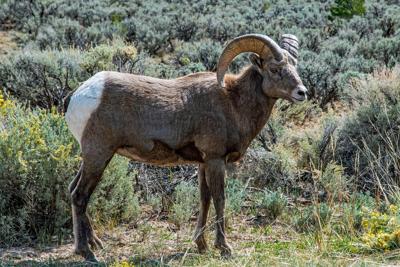For millions of years, America’s migratory big game herds moved unfettered across the continent in search of seasonal foods, mates and new habitats. Today, ancient species like elk, mule deer and pronghorn encounter a latticework of busy roadways, posing a danger to these animals and motorists alike.
Crashes or near-misses with wildlife occur frequently in the U.S., including in New Mexico. Local stories abound in Taos. In 2017, a Questa Police chief driving a detainee to the Taos County Jail collided with an elk on NM 522 near San Cristobal. Last November roughly 100 elk bedded down in grassland beside U.S. 64 before Taos Pueblo officials herded them to safety. Between Costilla and Questa, motorists can encounter hundreds of elk and wild horses, often at dawn or dusk.
This year New Mexico lawmakers have a chance to fund a proven solution to make these encounters less frequent and less dangerous: wildlife crossings — underpasses, overpasses, tunnels, culverts, or simply wildlife-friendly fencing that reduces the odds of wildlife-vehicle collisions.
Wildlife advocates and state transportation officials are hoping legislators will appropriate $50 million to the state’s Wildlife Corridors Fund, which Gov. Michelle Lujan Grisham signed into law in 2023. Given the frequency at which Taos County’s own human and animal populations run afoul of each other on local roadways, this is an allocation our legislators should get behind.
At an estimated cost of up to $150 million for a single wildlife crossing, the fund’s current $8.5 million balance is too anemic to finance projects on New Mexico roadways that need them most. According to the 2022 Wildlife Corridors Action Plan, an average of 911 crashes involving six species occurred in New Mexico in 60 “collision hotspots,” including U.S. 64, U.S. 84, U.S. 285 and NM 38 in Taos County.
Roadways cutting through wildlife habitat can also cause localized extinctions of animal species and shrink herd sizes. Wildlife corridors therefore enhance connectivity for wildlife, reconnecting fragmented species and encouraging healthy populations, according to the U.S. Fish and Wildlife Service. Such structures should also be built thoughtfully, with materials that don’t further endanger wildlife — like the West's ubiquitous barbed wire fencing, which can be hazardous to wild and domestic animals alike.
In a state with an already high rate of car accidents for its population size and where wildlife is continually imperiled by human activity, any step toward making New Mexico’s roads safer for both humans and animals is money well spent.
However, even if the state allocated the funding to construct wildlife crossings in every area that needs them, this won’t alleviate drivers’ responsibility to utilize common sense. Here are some basic rules to follow to avoid a collision with wildlife — or any other obstacle — while driving.
Slow down: Reducing speed improves a driver’s ability to avoid animals and other objects in the road. Avoiding speeding also shortens the distance required to stop and reduces the force of an impact during a collision. Maintain a safe distance from other cars in case of animal movements.
Drive defensively: A basic proviso of driver’s ed instructors and good parents/guardians everywhere — don’t drive aggressively. Instead, bear in mind the inherent danger of operating a motor vehicle and your duty to protect not only yourself and your passengers, but other commuters, pedestrians and animals in the roadway.
Avoid driving in the dark: Not only do low-light conditions make it harder to see the road and its surroundings, migratory big game species are on the move more often at dawn and dusk.
Make proper use of headlights: Always ensure headlights are on when driving in low light. Use high beams when traveling through areas with active wildlife populations. Remember to turn head beams down to avoid blinding oncoming traffic.
Think carefully before swerving: Choosing to avoid a collision is a judgement call, often made in a split-second. If a collision is unavoidable and is likely to result in less damage or injury than swerving, apply your brakes instead of making a sudden change in direction.
Scan the road and shoulders: Situational awareness is imperative when driving, including being attuned to what lies ahead down the roadway and to the either side of it.
Wear a seatbelt: According to the National Highway Traffic Association, seat belts reduce the risk of serious injury or death in the event of a collision by 50–60 percent.
Be awake, alert and sober: Driving is inherently dangerous, but becomes exponentially more so when drivers are exhausted or under the influence of drugs or alcohol.
This year’s proposed appropriation to the Wildlife Corridors Fund is about more than just safety — it’s about preserving the majestic wildlife that’s roamed New Mexico lands long before modern human development. It’s important legislators continue to fund wildlife corridors and other safety measures to allow these species to survive and flourish for years to come.












(0) comments
Welcome to the discussion.
Log In
All comment authors MUST use their real names. Posts that cannot be ascribed to a real person
will not be moderated.
Keep it Clean. Please avoid obscene, vulgar, lewd, racist or sexually-oriented language.
PLEASE TURN OFF YOUR CAPS LOCK.
Don't Threaten. Threats of harming another person will not be tolerated.
Be Truthful. Don't knowingly lie about anyone or anything.
Be Nice. No racism, sexism or any sort of -ism that is degrading to another person.
Be Proactive. Use the 'Report' link on each comment to let us know of abusive posts.
Share with Us. We'd love to hear eyewitness accounts, the history behind an article.